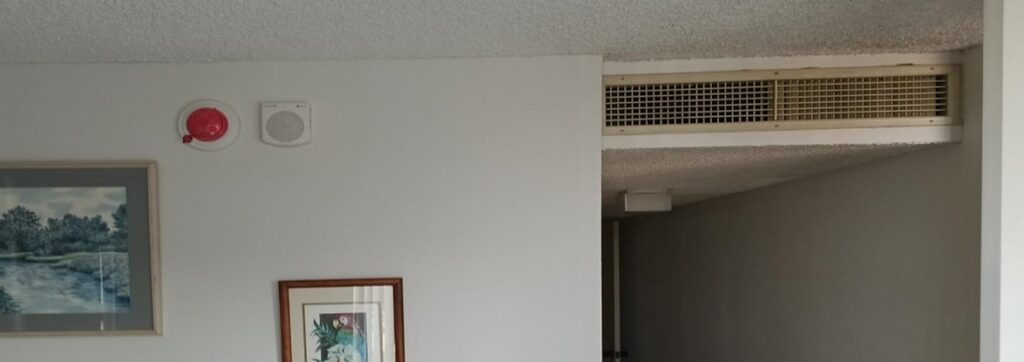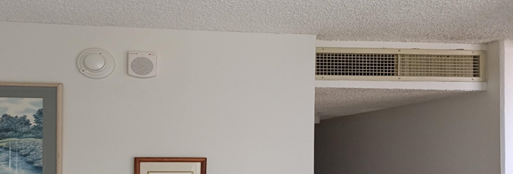Background
As a result of the fire at the Marco Polo Condominium that caused 4 deaths and over $100 million in damage, the City and County of Honolulu created Ordinances 18-14, 19-04 and 22-02 to improve fire life safety in the 323 identified high rise condominiums in Honolulu. The Ordinances require all unsprinkled high-rise residential buildings to either:
(1) Be retrofitted with automatic sprinklers monitored by a fire alarm system by May 3, 2038, or
(2) Pass a Fire Life Safety Evaluation (FLSE) by May 3, 2030. The evaluation is an assessment by a licensed design professional of the building’s safety features and fire protection systems to determine if the building meets a minimum level of fire and life safety for occupants and fire fighters required by the Fire Code and building code. After successfully remediating the items needed to pass the FLSE, Owners will vote to either opt out of installing a sprinkler system or to proceed with installing a sprinkler system for their condominium.
What will Yacht Harbor Towers (YHT) need to do to comply with the new Honolulu Fire Department Sprinkler retrofit Ordinances?
Of course, YHT is included and must meet the requirements of the Ordinances. Because YHT’s 50 year old alarm system is obsolete and is not capable of supervising an automatic fire sprinkler system, a new fire alarm system is a required first step. Once all the FLSE elements have been remediated, the YHT Owners will vote whether to have sprinklers or not.
YHT chose to submit a FLSE instead of installing sprinklers due to the significant additional cost of sprinklers. Wiss, Janney, Eisner Associates (WJE) completed the FLSE and the FLSE was submitted to the Honolulu Fire Department on April 29, 2022. WJE identified eleven items that need to be remediated in order to pass the FLSE. To meet the ordinance requirements, YHT must complete the required FSLE improvements by May 3, 2030.
The most significant improvement needed to pass the FLSE is installation of a new fire alarm system. YHT’s 50 year old fire alarm system is obsolete and is not capable of supervising an automatic fire sprinkler system. In addition, the existing system is no longer supported by the manufacturer; spare parts to maintain the system are generally not available; and the system lacks new technology to make the system more efficient and effective in the event of a fire.
Another requirement of the FLSE is that unit entry doors are solid core, fire rated doors that have working self-closing devices and smoke seals. Properly operating door closers and smoke seals will minimize the potential for a fire to escape from the unit of origin and spread to other units or areas. To meet the FLS requirements, Unit doors must be solid core, have weather stripping/smoke seals and that self-closing devices are operating properly. A survey of all Unit doors is being conducted to determine whether Unit doors will be remediated or replaced.
The importance of residents ensuring that their unit entry doors are securely closed at all times cannot be more strongly emphasized.
Please see the YHT Town Hall presentation or the YHT Fire Life Safety Review on the YHT website, www.yachtharbortowers.org, for details on the additional remediations required to pass the FLSE.
Were sprinklers considered and why not just proceed with sprinklers?
A fire sprinkler system without a supporting fire alarm system in a condominium building such as YHT does not meet Honolulu Fire Code. The Honolulu Building Code requires a fire alarm system to monitor fire sprinkler water flow and control valve status. A new fire alarm system is required, whether it is to pass the FSLE or if it is to install sprinklers. Installation of the new fire alarm system is a prerequisite step to sprinkler installation if owners decide to install sprinklers.
What is the YHT Fire Protection Life Safety Strategy?
Prior to completing the FLSE, WJE reviewed the specific construction features of the building, historic fire data for similar buildings, Honolulu Fire Department response times, and other factors. From this effort a fire protection life safety strategy was developed specific to YHT. The goals of the fire protection life safety strategy and proposed improvement measures are as follows:
- Prompt notification of occupants within the unit experiencing fire – Installation of new combination smoke/carbon monoxide detectors and audible speakers
- Notify other occupants of the property – Installation of the new fire alarm system with audible speakers and visual devices in the common area
- Confine smoke and fire within Unit of origin – Unit entry door remediation
- Provide safe occupant egress – Emergency Evacuation Plan, unlock stairwell doors
- Notify the Fire Department – Security and the Fire Department are automatically notified
- Facilitate fire fighter operations – Honolulu Fire Department communication system
What were the review procedures in selecting a new fire alarm system?
WJE/Tanner Engineering were selected to recommend and design the new fire alarm system. The functionality of the fire alarm is prescribed by the Honolulu Fire Code and referenced standards.
WJE/Tanner Engineering and TCS (Total Class Solutions, YHT’s Project Manager) interviewed representatives of the major fire alarm manufacturers with offices located on island, including Edwards, Simplex, Notifier, Autocall, and Siemens. A rigorous review of the features of each manufacturer’s product was completed to determine which manufacturer’s product would most benefit YHT. An important requirement was that the devices have multiple suppliers and that they can be supported by multiple local companies.
After a competitive RFP (Request for Proposal) process, Autocall equipment was selected. Wasa Electrical Services, Inc. (Wasa), the low bidder, was selected as the prime contractor, with fire alarm equipment provided by ProTech Fire and Security, a local Autocall distributor.
Was wireless considered and why was it not selected as it appears to be less expensive and easier to install?
Wireless was YHT’s first choice, and a substantial amount of time was spent exploring wireless options. This included review of technical product information from multiple manufacturers who sell wireless fire alarm equipment and interviews with wireless manufacturer representatives. No wireless manufacturer we interviewed submitted a bid for the work. Interviews with the major fire alarm manufacturers found that none of the major manufacturers (see list above) sell wireless products for use in commercial buildings. This is primarily because the connectivity of wireless signals in a building constructed of concrete, such as YHT, is very limited. Wireless fire alarm products are typically used in single family homes, which are constructed primarily of wood and gypsum board walls.
Through our research we learned:
• The Honolulu Fire Code requires system annunciators that will provide an audible alarm and verbal instructions to the unit residents. These speakers are one way devices and will not allow residents to speak to security. These devices are not available in wireless format.
• None of the major manufacturers (see list above) sell wireless products for use in buildings such as YHT.
• YHT consultants, WJE/Tanner Engineering, and contractor Wasa are not aware of a building similar to YHT that is using wireless technology.
In addition, the selected Autocall devices include several advantages over wireless devices including central reporting, non-disruptive self-testing devices, commercial level support and substantially reduced maintenance support.
In summary, TCS/WJE/Wasa/Protec were not able to identify a wireless system that meets Honolulu Fire Code requirements for YHT’s buildings.
What has been causing the delays and what is the current status of the project?
Substantial delays have been caused while waiting for the City and County of Honolulu Department of Planning and Permitting approval of the building permit that was submitted on October 26, 2021. Supply chain constraints on the fire alarm system components continue to cause delays. A Special Assignment Inspection permit was approved on February 10, 2023 which will allow YHT to proceed with the installation of the fire alarm system while the official building permit is still in review.
Installation of the system in the Ewa Tower residential units is scheduled to start on 1/29/24. The Pre-Construction meetings are scheduled to start on 1/8/24. Detailed schedules for Unit Pre-Construction meetings and the construction installation schedule in the Ewa Units are available on the Wasa website.
The Wasa website also contains impact maps for each unit that indicate where the devices will be installed and the areas in the unit that need to be cleared for the installation.
How will the new Fire Alarm System be paid for?
The new Fire Alarm System has been included in the Reserve plans by the Association and will be paid through existing reserves. A separate owner assessment for the Fire Alarm System will not be required.
However, if a custom installation is requested by the owner or is required due to owner renovations in the unit, additional device and labor costs will be the responsibility of the unit owner. This will be discussed at the pre-construction meeting for your unit.
The two week time to install the fire alarm upgrade in each Unit seems excessive compared to the complex repipe project. Can the time be compressed to reduce the impact to the residents?
Wasa is one of the largest, most experienced fire alarm installers on island. The plan Wasa developed for YHT utilizes several work teams that will be working in multiple units at the same time. This is the most efficient and cost effective way to complete the work. Efficiencies gained by this method will result in substantially improved project completion, 10 months vs 24 months required for the repipe project. In addition, this method contributed to a substantial reduction of the contract cost where Wasa was the low bidder by a significant margin. Based upon their experience with their work in the Ewa Tower, Wasa will be looking for opportunities to improve the unit work schedule going forward.
What happens at the pre-construction meeting?
A pre-construction walkthrough meeting will be scheduled approximately 3 weeks prior to the work starting in your unit. During the walkthrough, Wasa will explain the kind of work that will be performed and what you’ll need to do before and during construction. These obligations can be performed by the Owner or the Owner’s Agent. If you have tenants, we request that your tenants be present at the walkthrough so that they are also informed about the work. The meeting should take about 15 minutes.
Can I reschedule the fire alarm installation in my unit?
Rescheduling the work in any unit can affect the timeline of the project and will increase the cost of the project. Accordingly, either the Owner or Authorized Agent must attend all scheduled meetings and allow access to the unit during scheduled construction days. Inability to do so will result in delay charges billed to the unit Owner.
How will the new fire alarm system affect the aesthetics of my Unit?
Hours of coordination and design review were spent to achieve the best solution for the wiring and device locations in the units. Wires in the units will be run in the drop ceilings or will be covered with appropriate molding. The pictures below show typical device installations.

Flush mount wall combination smoke/carbon monoxide detector and fire alarm speaker. Typically installed in drywall. The red cover on the smoke detector will be removed after fire department inspection.

Devices after fire department approval. Red covers removed.

Surface mount combination smoke/carbon monoxide detector and fire alarm speaker. Typically installed on concrete walls. The red cover on the smoke detector will be removed after fire department inspection.
Will the fire alarm wiring be exposed?
Hours of coordination and design review were spent to achieve the best solution for the wiring in the units and in the hallways. Wires in the units will be run in the drop ceilings or will be covered with appropriate molding. In the exterior hallways, wires will be in conduit attached to the exterior hallway walls. The conduit will be painted to match the building walls. This approach provides an aesthetically pleasing solution. In addition, if and when YHT is retrofitted with fire sprinklers, the exterior sprinkler piping can be run along the same path as the fire alarm wire, and both enclosed in a soffit or other architectural element.
Can I reschedule the fire alarm installation in my unit?
Rescheduling the work in any unit can affect the timeline of the project and will increase the cost of the project. Accordingly, either the Owner or Authorized Agent must attend all scheduled meetings and allow access to the unit during scheduled construction days. Inability to do so will result in delay charges billed to the unit Owner.
How will the contractor get access to my unit?
The unit Owner or Authorized Agent will select one of the following options during the pre-construction meeting:
- Permit the use of keys maintained on site by the AOUO for entry to the unit. The AOUO will confirm individual residential unit keys in possession of the AOUO operate the lock mechanism at the pre-construction meeting.
Unit keys will remain in the possession of a security representative throughout the work day. The security representative will unlock the unit door for installation activities scheduled for your unit. The keys will be returned to the YHT Management Office nightly and checked out again each morning. - Be home or have your Authorized Agent be present daily from 8:00am to 4:30pm to allow access as needed by the construction staff during the scheduled work days.
What if my tenant or I do not allow access into my unit?
Since the entire building will need to be complete in order to pass the Honolulu Fire Department inspection, any denied access to a unit will cause a delay, not only to the delaying unit, but to the overall work schedule as well. Delays will result in additional costs charged to the unit Owner. The Denied Access Policy and fees are included in the Apartment Access & Work Authorization form which will be discussed at the pre-construction meeting.
I have a dog or cat. What do I do with my animal during the day?
You must secure your animal in an area that will not impede access to the work or construction zones. Please note, the contractor is not responsible for securing, injuries to, or lost animals.
My unit has been remodeled. How will this affect the work I have done?
All finishes will be restored to standard original building conditions. For further information, please refer to the YHT Original Building Condition Disclosure Form. If you have questions about the Original Building Condition Policy, please discuss them at the pre-construction meeting.
I have new state of the art smoke detectors in my unit, can I opt out of the new fire alarm system?
In order to meet the Honolulu Fire Code all 456 residential units and the two commercial units in the Ewa Tower must have the new fire alarm system installed and operational. As such, opt out requests cannot be honored.
Can I have the devices installed at locations other than shown on the impact maps?
The locations of the devices shown on the impact maps were chosen to meet building and fire codes, to minimize installation costs and to maximize the ability to conceal the wiring. If there is a need to relocate devices, the request will be considered. Small movement on the same wall can likely be considered at the pre-construction meeting. Substantial movement, such as to another wall, will require review by WJE for Fire Code compliance and by Wasa for installation feasibility. Additional costs to evaluate device relocation and to relocate the devices will be the responsibility of the unit Owner.
Can I paint or conceal the devices?
Painting or concealing the devices is not permitted. Concealing the devices may negatively impact audibility and the application of paint will void the manufacturer’s warranty.
The red covers on the devices are unsightly, can I remove them?
The Honolulu Fire Department requires that the red covers remain in place until the devices are tested by the Fire Marshall in your unit. If the Fire Marshall finds the covers have been removed, they can require that the devices be replaced. Replacement of such devices will be at the expense of the unit Owner.
Is the contractor responsible if something gets stolen from my unit?
An Association security officer will be assigned to oversee specifically the construction project. We strongly advise you to remove and secure ANY valuable items from all work and traffic zones. In the event that there is a missing item, inform the Wasa project manager immediately and file a police report.
Is the contractor responsible if they break something?
Yes, Wasa is insured and responsible for any accidental damages during construction. However, they will not be responsible for existing damages in the unit uncovered due to construction.
What onsite communication is needed for the Honolulu Fire Department?
Honolulu Fire Code requires that YHT install a communications system throughout the property to support firefighting activities. Options for the communications system are currently being evaluated. Installation of the selected option will be integrated into the current fire alarm system upgrade.
